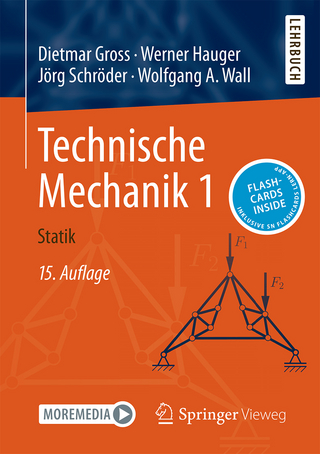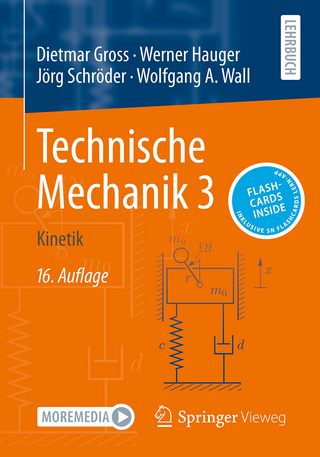
Design of Piles Under Cyclic Loading
ISTE Ltd and John Wiley & Sons Inc (Verlag)
9781786301987 (ISBN)
- Titel ist leider vergriffen;
keine Neuauflage - Artikel merken
Alain Puech, Grenoble-Alpes University, France. Jacques Garnier, Grenoble-Alpes University, France.
Foreword xi
Preface xv
List of Symbols xix
Chapter 1 SOLCYP Project 1
1.1 Motivations 1
1.2 The SOLCYP project 2
1.2.1 The ANR-SOLCYP program 3
1.2.2 The national SOLCYP project 4
1.2.3 Organization of the PN-SOLCYP 8
1.3 Content and nature of this book 9
1.4 Regulatory context 10
1.5 Bibliography 11
Chapter 2 Scope and Field of Application of Recommendations 13
2.1 Variable loading and cyclic loading 13
2.2 Structures to which this discussion pertains 14
2.3 Effects of cyclic loading on the foundations 16
2.4 Types of piles 17
2.5 Types of soils 18
2.6 Bibliography 18
Chapter 3 Cyclic Loading 21
3.1 General 21
3.2 Characterization of cyclic loads 22
3.2.1 Regular loading: definitions 22
3.2.2 Cyclic loading of soil samples in the laboratory 23
3.2.3 Real-world cyclic loading 24
3.3 Taking account of real cyclic loading in the design process 24
3.3.1 Principle and definitions 24
3.3.2 Counting methods 27
3.3.3 Damage laws 27
3.4 Bibliography 38
Chapter 4 Introduction to Cyclic Degradation 41
4.1 Introduction 41
4.2 Cyclic degradation of soil properties 41
4.2.1 Recap of the response of soils to monotonic loading 41
4.2.2 Soil response to cyclic loading 42
4.2.3 Contour diagrams 44
4.2.4 Generalized contour diagrams 47
4.2.5 Obtaining contour diagrams for a particular soil 54
4.2.6 Cyclic degradation of the shear modulus 55
4.3 Cyclic degradation of soil–pile interfaces 59
4.3.1 General considerations on soil–pile interface tests 59
4.3.2 SOLCYP databank on direct shear soil–pile tests 66
4.4 Cyclic degradation of pile response 70
4.4.1 Piles subjected to axial cyclic loading 70
4.4.2 Piles subject to lateral cyclic loading 84
4.5 Appendices 91
4.5.1 Appendix 1: Program of CNL and CNS tests and parameters influencing their outcome 91
4.5.2 Appendix 2: CNS tests Corrections to be made to the raw measurements 95
4.6 Bibliography 96
Chapter 5 SOLCYP Design Strategy 101
5.1 General methodology 101
5.2 Knowledge of loads 103
5.3 Analysis of regulatory loads 105
5.4 Criteria of cyclic severity for axial loads 106
5.4.1 Axial capacity of piles: definitions 106
5.4.2 Use of the cyclic stability diagram 107
5.4.3 Influence of soil–pile relative stiffness 114
5.5 Cyclic severity criteria for transverse loading 115
5.5.1 Case of sands 115
5.5.2 Case of clays 117
5.6 Detailed characterization of the cyclic loads 119
5.7 Cyclic pile design methods 121
5.8 Obtaining the parameters 122
5.9 Bibliography 122
Chapter 6 Behavior of Piles Subject to Cyclic Axial Loading 125
6.1 Introduction 125
6.2 Large international programs 127
6.3 Tests in clay soils 132
6.3.1 Normally consolidated to slightly overconsolidated clays 132
6.3.2 Highly overconsolidated clays 137
6.3.3 Comparisons of the results 144
6.4 Tests in sands 146
6.4.1 Silica sand 146
6.4.2 Carbonate soils 158
6.5 About the static load-bearing capacity 160
6.5.1 Ageing in sands 160
6.5.2 Effect of time and preshearing in clays 161
6.5.3 Softening 162
6.5.4 Loading rate 162
6.6 Summary 163
6.7 Appendix: cyclic loading tests on piles at the Merville site 165
6.7.1 Introduction 165
6.7.2 Results obtained on two driven piles (B1 and B4) 166
6.7.3 Results obtained on bored (CFA) piles 167
6.7.4 Results obtained on bored screw piles 169
6.8 Bibliography 170
Chapter 7 Design of Piles Subjected to Cyclic Axial Loading 177
7.1 Introduction 177
7.2 General principles 178
7.3 The NGI approach 180
7.3.1 Fundamental principles 180
7.3.2 PAXCY and PAX2 programs 182
7.4 The ICL approach 184
7.4.1 Basic principle 184
7.4.2 The ABC global method 185
7.4.3 Local applications of the ABC method 188
7.5 The RATZ-CYCLOPS suite of programs 188
7.6 The SCARP program 191
7.6.1 Description of the SCARP program 191
7.6.2 Calibration of the SCARP program 195
7.7 Finite Element Method approaches 201
7.8 The SOLCYP approach for non-cohesive soils 203
7.8.1 General principles 203
7.8.2 Choice of parameters to characterize the soil–pile system 204
7.8.3 Modeling of the results of direct soil–structure shear 207
7.8.4 Modeling by the t–z envelope curve method 208
7.8.5 Modeling by the method of t–z cyclic curves (TZC software) 211
7.8.6 FEM modeling 217
7.8.7 Case of driven piles 224
7.9 Bibliography 225
Chapter 8 Behavior of Piles Subject to Cyclic Lateral Loading 233
8.1 Soil–pile interaction under lateral loading 233
8.1.1 Relative stiffness 234
8.1.2 Concept of lateral reaction 236
8.1.3 Crucial role of surface layers 236
8.2 Main experimental data 238
8.3 Available data on the effect of the cycles 240
8.3.1 Effect of cycles on the pile’s lateral displacement 240
8.3.2 Effect of cycles on the maximum bending moment in the pile 252
8.3.3 Effect of cycles on the P–y reaction curves 256
8.4 Contribution of the SOLCYP project 259
8.4.1 Context and scope of the studies conducted 259
8.4.2 Testing conditions 260
8.5 Data obtained on the effect of cycles 263
8.5.1 Case of sands 264
8.5.2 Case of clays 271
8.6 Final overview of the data on the effect of cycles 285
8.6.1 Effects on pile head displacement 286
8.6.2 Effects on the maximum moment and the reactions in the soil 291
8.7 Bibliography 292
Chapter 9 Design of Piles Subject to Cyclic Lateral Loading 299
9.1 Recap of the current rules 300
9.2 Methodology to take account of cyclic loads 303
9.3 Taking account of the cycles by the global method SOLCYP-G 305
9.3.1 Principles of the global method 305
9.3.2 Conventional limit load and failure load 305
9.3.3 Degree of relative stiffness of the pile and limits of flexible and rigid piles 308
9.3.4 Presizing of the pile subject to the maximum static load Hmax 311
9.3.5 Cyclic severity criteria 314
9.3.6 Effect of cycles on the pile head displacement 315
9.3.7 Effect of cycles on the maximum bending moment 319
9.4 Taking account of cycles by a local method SOLCYP-L 319
9.4.1 Principle of the local method 319
9.4.2 Determination of the P-multipliers for monotonic P–y curves 320
9.5 Domains of validity and example of application 323
9.5.1 Domains of validity of the global method SOLCYP-G and local method SOLCYP-L 323
9.5.2 Example of application of the global and local methods 327
9.6 Conclusion 345
9.7 Bibliography 345
Chapter 10 Determination of Cyclic Parameters for Pile Design 347
10.1 Introduction 347
10.2 Parameters for the design of piles subjected to cyclic loads 348
10.2.1 Mineralogy 350
10.2.2 Parameters for monotonic calculations 351
10.2.3 Cyclic parameters 352
10.2.4 Consolidation parameters 352
10.2.5 Remolding parameters 353
10.3 Obtaining the parameters for the design of piles subjected to cyclic loading 353
10.3.1 Lab tests 353
10.3.2 In situ tests 365
10.4 Bibliography 370
Chapter 11 Recommendations for Testing Piles Under Cyclic Loading 377
11.1 Introduction 377
11.2 Reasons for the tests 378
11.3 The different test methods 379
11.4 Contribution of calibration chamber tests: Axial loading 381
11.5 Contribution of centrifuge tests: Axial or transverse loading 383
11.6 In situ axial loading tests 384
11.6.1 Objectives of the test 384
11.6.2 Design support tests (FEED tests) 385
11.6.3 Validation tests (Non-Working Pile Tests) 391
11.6.4 Control tests (Working Pile Tests) 393
11.7 Transverse loading tests in situ 394
11.7.1 Objectives and representativity of tests 394
11.7.2 Design support tests (FEED tests) 395
11.7.3 Validation tests (Non-Working Pile Tests) 399
11.7.4 Control tests (Working Pile Tests) 400
11.8 Appendix 1: Recap on scaling effects 401
11.8.1 Tests on reduced-scale models in the lab 402
11.8.2 Tests of piles in situ 404
11.9 Appendix 2: In situ axial loading 404
11.9.1 Test setup 404
11.9.2 Instrumentation and data acquisition 406
11.10 Appendix 3: Transverse loading in situ 409
11.10.1 Test setup 409
11.10.2 Instrumentation and data acquisition 411
11.11 Bibliography 413
Index 417
| Erscheinungsdatum | 17.11.2017 |
|---|---|
| Verlagsort | London |
| Sprache | englisch |
| Maße | 163 x 239 mm |
| Gewicht | 1134 g |
| Themenwelt | Naturwissenschaften ► Physik / Astronomie ► Mechanik |
| Technik ► Bauwesen | |
| Technik ► Maschinenbau | |
| ISBN-13 | 9781786301987 / 9781786301987 |
| Zustand | Neuware |
| Informationen gemäß Produktsicherheitsverordnung (GPSR) | |
| Haben Sie eine Frage zum Produkt? |
aus dem Bereich


